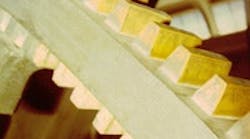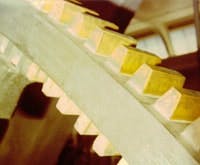Gears have been with us for at least 3,000 years and they’ve been improved over the years. About 200 years ago, a typical large gear would be a wooden rim with wooden teeth inserted around the circumference (Figure 1). The teeth were pinned in place, simplifying maintenance because a broken tooth could be changed out easily.
Figure 1. About 200 years ago, a typical large gear would be a wooden rim with wooden teeth inserted around the circumference.
A modern gear drive can be considered as a box of machine components: bearings, shafts, shaft seals and gears. The gear teeth cut into the blank have a shape known as an involute. The involute shape, when manufactured to specific tolerances, then transmits motion at a constant speed. A major feature of a gear drive is that for a constant horsepower, torque is an inverse function of speed. With a speed reduction, the turning torque increases in proportion to the reduction ratio. It’s possible to use this characteristic to increase the prime mover’s turning torque by a factor of as much as 1,700. Achieving this kind of performance requires paying attention to the best practices for selecting, installing and operating geared drives.
Pick a winner
Manufacturers of gear drives are offering many different types of gears. If you can’t find a supplier in your area, contact the American Gear Manufacturers Association for suggested manufacturers. The selection of an appropriate manufacturer depends on the product’s features, as well as your own economic considerations.
Define your horsepower and speed-reduction requirement. Describe your application, the service time in hours per day, the environment for the operation, the mounting position for the drive and any size limitations. The AGMA establishes suggested service factors for different applications, based on the experiences of its members. Multiplying these service factors by the motor horsepower determines the required horsepower used for selecting the size of the gear drive. These factors take into consideration twin realities: an applied load is never uniform and the degree of load variation is a function of the specific application.
A gear’s dimensional accuracy is important and the AGMA developed accuracy specifications for the elements of gear geometry. The levels of accuracy are known as quality numbers. AGMA quality level 9 is adequate for most commercial gear drives. Drives that need greater reliability must be made more accurately, and an AGMA quality of 12 to 15 might be required. Remember, the higher the level of accuracy, the higher the price of the gear.
Use a solid foundation
Once you determine the size of the drive, your next consideration is the mounting surface. Provide a solid foundation that won’t sag or crack. Once the drive is properly aligned to the prime mover and driven equipment, it must stay aligned.
If you use a concrete foundation, allow the concrete to cure completely before mounting the drive on it. Don’t mount the drive directly on the concrete, though. The best mounting uses structural steel mounting pads that are grouted into the concrete. The steel mounting pads provide the drive with a flat, level surface, making the installation of the drive an easier task. After the drive is in operation, check the foundation periodically for cracks and check the shaft alignment. Mount the drive above the floor level to facilitate oil changes. The drain plug should be at the lowest point on the housing.
Connect and align
A drive usually has two shaft connections: an input shaft for the prime mover and an output shaft for the driven equipment. Possible connecting devices include couplings, chains, pulleys or sheaves with V-belts. Whatever device you use, mount it as close as possible to the drive housing to minimize the overhung load caused by the pull of the chain or belt. The rotating shafts, of course, require guards that meet OSHA requirements. The guards might be available from the drive manufacturer.
Align the drive with flat, broad shims inserted under the drive’s mounting pads. Starting at one end of the drive, level along the length and then across the width. Shaft extensions can be used for leveling, as well as pads machined into the housing that facilitates lateral and longitudinal alignment.
Check each mounting foot with a feeler gauge to ensure that each pad provides support, thus minimizing housing distortion when the drive is bolted down. After the unit is aligned with the driven machine and bolted down, align the prime mover to the unit input shaft. If the prime mover was factory-aligned to the drive, ensure that the alignment didn’t shift during transit.
It’s important to maintain shaft alignment because shaft misalignment might have an adverse effect either on the device connecting the shafts or on the bearings and the drive’s internal shafting. A gear drive is designed to accept a certain amount of overhung load, and bearings are selected and shafts are designed to accommodate those anticipated loads. With the exception of an elastomer coupling, a misaligned coupling produces an appreciable radial overhung load (at right angles to the shaft axis) on the shaft that can overload the bearings and can stress the shaft beyond its fatigue strength.
Remember the oil
Before starting the drive, confirm that the oil level is adequate. Either the drive manufacturer or oil supplier can provide a list of approved lubes and the proper viscosities. The manufacturer specifies an oil level low enough so that gears churning through the oil bath won’t produce excessive heat and oil won’t leak out of the air vent. The oil level must be high enough, though, to lubricate the moving parts and still minimize the temperature rise during operation.
If the transmitted load exceeds the gear drive’s thermal rating, auxiliary cooling in the form of fans or heat exchangers will be necessary. A gear drive should operate with a maximum temperature rise of 100°F over ambient temperature. Under certain conditions, this temperature limit can be exceeded; however the maximum sump temperature should never exceed 200°F.
Proper oil level can be monitored by one of several methods. It might be as simple as watching for excess oil to flow out of a tapped hole at a level specified by the manufacturer that is then plugged. A sight gauge with a marked oil level has two limitations. It’s fragile, so you must be careful not to break the glass. In time, the glass will fog up, making it difficult to read the gauge. A third method is a dip stick, similar to the one used in a car, marked with a high/low mark. Regardless of how you determine oil level, the unit must be at rest when the level is checked.
Baselining for reliability
The value of baseline data is that they allow you to compare current operational variables with the baseline data and head off any incipient problems. After the drive is commissioned, it’s a good practice to establish a baseline for its operating temperature, noise level and any noticeable vibration. When possible, note the contact of any gear. This might not always be possible because some drives don’t have an inspection port. It’s wise to specify that any new gear drives have an inspection port so you can monitor for abnormal gear wear.
Mothballing the box
Sometimes a gear drive must be placed in storage for a period of time. Perhaps the construction project is delayed. Perhaps economic conditions require shutting down a production line. Whatever the reason, it’s important to protect the drive from moisture, which will cause corrosion on the gear surfaces and premature bearing failure. If the drive is small and has a contact-type shaft seal, fill the drive completely with oil. Each drive has an air vent, which should be removed and replaced with a pipe plug. Put the vent in a cloth bag and attach the bag to the drive. Apply tape to the sealing surfaces for each shaft extension to prevent oil leakage and air ingress.
If the drive is large and can’t be completely filled with oil, spray the internal parts with oil-soluble rust preventive and completely seal the drive. An alternate method is to use a vapor-phase rust inhibitor in the quantity suggested by the manufacturer, typically an ounce per cubic foot of interior volume. In either case, remove the air vent and tape the shaft seals.
Before placing a mothballed gear drive into service, be certain it’s filled to the correct level with the proper oil.
Potential problems
The lubricant in any gear drive can become unusable in two ways. The oil can oxidize if the operating temperature exceeds 230°F. The oil can become contaminated with metal particles or moisture. Gear drive lubricant moisture levels as low as 100 parts per million (ppm) reduce the life of ball bearings by 30% to 50%. Metallic wear particles erode the bearing races and should be removed. Periodically, sample the oil and check for contamination and oxidation.
Nothing is perfect, and problems can arise immediately after operation starts or after a period of time. If oil is leaking through the contact seals immediately after startup, it’s possible that the seal lip was cut during installation. If leakage occurs in only one direction of operation, it’s possible that the machining scratches on the sealing surface have a helix arising from the transverse motion of the grinding wheel. Oil leakage through the air vent can indicate too high an oil level. A noise level greater than 92 dB A might be a reflection of the gear dimensional accuracy. Excessive vibration might be caused by misalignment.
Donald L. Borden, P.E., is president of D.L. Borden Inc., Brookfield, Wis. Contact him at [email protected] and (262) 784-9474.

